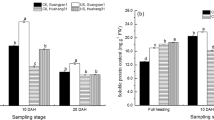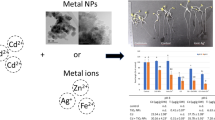Abstract
Heavy metals have long-term adverse impacts on the health of soil ecosystems and even exhibit hazardous influences on human health. Literatures have shown that heavy metals could result in the reduction of crops growth and development and finally result in crops production decline. To determine whether or not ultrasonic vibration alleviate damage induced by cadmium and lead in crops, the wheat seeds, which is one of the most important agriculture crops in China and other countries in the world, were exposed to 10 min ultrasonic vibration and then the toxicological effects were investigated. Wheat seeds were soaked for 3 h with water and then the seeds were placed in clean beaker with some water, the beaker were placed in ultrasonic apparatus to vibrate (model, KQ-200VDV; frequency, 45 KHz; power, 160 W). Pretreatment seeds of 80 were sown in dishes (Ø 15 cm). After seeds emergence, the seedlings were thinned to 60 per dish. The dishes with seedlings were placed in a growth chamber maintained at 25 °C, 70 % relative humidity and 380 μmol mol−1 CO2 under dark condition. A 400 μmol m−2 s−1 photosynthetically active radiation was provided for 8 h (dark for 16 h) after the seed germination. When the seedlings were 2 days old, the seedlings were subjected to cadmium and lead for 4 days and then some selective biochemical and physiological parameters were measured. (1) Although each doses of ultrasonic vibration could improve seed germination, enhance biosynthesis of protein and chlorophyll and seedlings growth, the optimum dosage of ultrasonic vibration was 10 min. (2) Compared with the controls, cadmium and lead stress led to significant increase in the concentrations of malondialdehyde (MDA) and O−2 and in the conductivity of electrolyte leakage, but the activities of catalase (CAT), superoxide dismutase (SOD), glutathione reductase (GR), the glutathione concentration, and the shoot weight were decreased by Cd and Pb stress. In the case of the seeds exposed to ultrasonic vibration and the seedlings followed by cadmium lead stress, the concentrations of MDA and O−2, and the conductivity of electrolyte leakage were significantly lower than those in cadmium and lead stress; the activities of CAT, SOD, and GR and the shoot weight were significantly higher (except for glutathione (GSH) concentration) than those in cadmium and lead stress seedlings. The membrane is responsible for the selective inflow and outflow of molecules, ions, and water, and is a dynamic structure that performs a variety of functions. Cellular membrane systems play an important role in the compartmentalization of cells and maintaining intercellular homeostasis. Abiotic and biotic stress can induce functional impairments to the cellular membrane systems through triggering an increased formation of reactive oxygen species (ROS), such as superoxide (O2 −), hydrogen peroxide (H2O2), and hydroxyl radicals. There are several pathways that can be utilized to eliminate ROS in plants, e.g., CAT, SOD, and GR and GSH, etc. compared with controls, cadmium, and lead enhanced the concentrations of ROS; decreased the SOD, CAT, and GR activities; the GSH concentration, and the seedling growth. In the case of ultrasonic pretreatment followed by cadmium and lead stresses, the activities of CAT, SOD, and GR were significant higher, and the conductivity of electrolyte leakage and the concentrations of MDA and O2 − were significant lower than that of those subjected by cadmium and lead stress. This phenomenon demonstrated ultrasonic pretreatment can help plant eliminate the ROS by enhance the activities of antioxidant enzymes. These results suggested that ultrasonic vibration can alleviate the toxicological effect induced by heavy mental.




Similar content being viewed by others
Abbreviations
- MDA:
-
Malondialdehyde
- TBA:
-
Thiobarbituric acid
- EDTA:
-
Ethylene diamine tetraacetic acid
- CK:
-
Without any treatment
- Cd:
-
Cadmium stress
- Pb:
-
Lead stress
- SV:
-
Ultrasonic vibration
- SV + Cd:
-
Ultrasonic vibration followed by cadmium stress
- SV + Pb:
-
Ultrasonic vibration followed by lead stress
- CAT:
-
Catalase
- SOD:
-
Superoxide dismudase
- GR:
-
Glutathione reductase
- GSH:
-
Glutathione
References
Agrawal G, Joshi S, Subramani S (2011) Cell-free sorting of peroxisomal membrane proteins from the endoplasmic reticulum. Proc Natl Acad Sci U S A 108:9113–9118
Aidid SB, Okamoto H (1992) Effect of lead, cadmium and zinc on the electric membrane potential at the xylem/symplast interface and cell elongation of impatiens balsamina. Environ Exp Bot 32:439–448
Alliger H (1975) Ultrasonic disruption. Am Lab 10:75–85
Bajji M, Kinet JM, Lutts S (2002) Osmotic and ionic effects of NaCl on germination, early seedling growth, and ion content of Atriplex halimus (Chenopodiaceae). Can J Bot 80:297–304
Baker AJM, Walker PI (1989) Physiological responses of plants to heavy metals and the quantification of tolerance and toxicity. Chem Spec Bioavailab 1:7–17
Bertrand M, Poirier I (2005) Photosynthetic organisms and excess of metals. Photosynthetica 43:345–353
Bhattacharyya P, Tripathy S, Chakrabarti K, Chakraborty A, Banik P (2008) Fractionation and bioavailability of metals and their impacts on microbial properties in sewage irrigated soil. Chemosphere 72:543–550
Bradford MM (1976) A rapid and sensitive method for the quantitation of microgram quantities of protein utilizing the principle of protein-dye binding. Anal Biol Chem 72:248–254
Breckle SW, Kahle H (1992) Effect of toxic heavy metals (Cd, Pb) on growth and mineral nutrition of beech (Fagus sylvatica L.). Vegetation 101:43–53
Cakmak I, Marschner H (1992) Magnesium deficiency and high light intensity enhance activity of superoxide dismutase, ascorbate peroxidase and glutathione reductase in Bean Leaves. Plant Physiol 98:1222–1227
Chaves MM, Maroco JP, Pereira JS (2003) Understanding plant responses to drought—from genes to the whole plant. Funct Plant Biol 30:239–264
Corpas FJ, Palma JM, Sandalio LM, Lopez-Huertas E, Romero-Puertas MC, Barroso JB, Del Rio LA (1999) Purification of catalase from pea leaf peroxisomes: identification of five different isoforms. Free Radic Res 31:235–241
Edmonds PD, Ross P (1988) Protein synthesis by neuroblastoma cells is enhanced by exposure to burst-mode ultrasound cavitation. Ultrasound Med Biol 14:219–223
Fechheimer M, Boylan JF, Parker S, Sisken JE, Patel GE, Zimmer SG (1987) Transfection of mammalian cells with plasmid DNA by scrape loading and sonication loading. Proc Natl Acad Sci U S A 84:8463–8467
Gao JF (2001) Technology of plant physiological experiment: method of determine O2− in plant. High Education Press, Beijing, pp 221–222
Giannopolitis CN, Ries SK (1977) Superoxide dismutase II: purification and quantitative relationship with water-soluble protein in seedlings. Plant Physiol 59:315–318
Griffith OW (1980) Determination of glutathione and glutathione disulfide using glutathione reductase and 2-vinylpyridine. Anal Biochem 106:207–212
Hattab S, Dridi B, Chouba L, Kheder MB, Bousetta H (2009) Photosynthesis and growth responses of pea Pisum sativum L. under heavy metals stress. J Environ Sci 21:1552–1556
Heiss S, Wachter A, Bogs J, Cobbett C, Rausch T (2003) Phytochelatin synthase (PCS) protein is induced in Brassica juncea leaves after prolonged Cd exposure. J Exp Bot 54:1833–1839
Hsu FH, Chou CH (1992) Inhibitory effects of heavy metals on seed germination and seedling growth of Miscanthus species. Bot Bull Acad Sin 33:335–342
Hughes DE, Nyborg WL (1962) Cell disruption by ultrasound. Science 138:108–113
Joersbo M, Brunstedt J (1992) Sonication: a new method for gene transfer to plants. Physiol Plant 85:230–234
Kawano T (2003) Roles of the reactive oxygen species-generating peroxidase reactions in plant defense and growth induction. Plant Cell Rep 21:829–837
Khan S, Cao Q, Zheng YM, Huang YZ, Zhu YG (2008) Health risks of heavy metals in contaminated soils and food crops irrigated with wastewater in Beijing, China. Environ Pollut 152:686–692
Khan S, Hesham AE, Qiao M, Rehman S, He JZ (2010) Effects of Cd and Pb on soil microbial community structure and activities. Environ Sci Pollut Res Int 17:288–296
Liao VH, Dong J, Freedman JH (2002) Molecular characterization of a novel, cadmium-inducible gene from the nematode Caenorhabditis elegans: a new gene that contributes to the resistance to cadmium toxicity. J Biol Chem 277:42049–42059
Liu JG, Li KQ, Xu JK, Zhang ZJ, Ma TB, Lu XL, Yang JH, Zhu QS (2003) Lead toxicity, uptake, and translocation in different rice cultivars. Plant Sci 165:793–802
Matés JM, Segura JA, Alonso FJ, Márquez J (2010) Roles of dioxins and heavy metals in cancer and neurological diseases using ROS-mediated mechanisms. Free Radical Biol Med 49:1328–1341
Meloni DA, Oliva MA, Martinez CA, Cambraia J (2003) Photosynthesis and activity of superoxide dismutase, peroxidase and glutathione reductase in cotton under salt stress. Environ Exp Bot 49:69–76
Miller MW, Miller DL, Brayman AA (1996) A reviews of in vitro bioeffects of inertial ultrasonic cavitation from a mechanistic perspective. Ultrasound Med Biol 22:1131–1154
Podazza G, Rosa M, González JA, Hilal M, Prado FE (2006) Cadmium induces changes in sucrose partitioning, invertase activities, and membrane functionality in roots of rangpur lime (Citrus limonia L. Osbeck). Plant Biol 8:706–714
Predieri S, Norman HA, Krizek DT, Pillai P, Mirecki RM, Zimmerman RH (1995) Influence of UV-B radiation on membrane lipid composition and ethylene evolution in ‘Doyenne d’Hiver’ pear shoots grown in vitro under different photosynthetic photon fluxes. Environ Exp Bot 35:151–160
Ramachandra RA, Viswanatha CK, Vivekanandan M (2004) Drought induced responses of photosynthesis and antioxidant metabolism in higher plants. J Plant Physiol 161:1189–1202
Reinheckel T, Noack H, Lorenz S, Wiswedel I, Augustin W (1998) Comparison of protein oxidation and aldehyde formation during oxidative stress in isolated mitochondria. Free Radical Rese 29:297–305
Shah K, Dubey RS (1995) Effect of cadmium on RNA level as well as activity and molecular forms of ribonuclease in growing rice seedlings. Plant Physiol Biochem 33:577–584
Sinisterra JV (1992) Application of ultrasound to biotechnology: an overview. Ultrasonics 30:180–185
Smith IK, Vieweller TL, Thorne CA (1988) Assay of glutathione reductase in crude tissue homogenates using 5, 5′-dithiobis (2-nitrobenzoic acid). Anal Biochem 175:408–413
Van der ZA, Braakman I, Tabak HF (2010) Peroxisomal membrane proteins insert into the endoplasmic reticulum. Mol Biol Cell 21:2057–2065
Verma S, Dubey RS (2003) Lead toxicity induces lipid peroxidation and alters the activities of antioxidant enzymes in growing rice plants. Plant Sci 164:645–655
Yadav SK (2010) Heavy metals toxicity in plants: an overview on the role of glutathione and phytochelatins in heavy metal stress tolerance of plants. S Afr J Bot 76:167–179
Yamaguchi-Shinozaki K, Shinozaki K (2006) Transcriptional regulatory networks in cellular responses and tolerance to dehydration and cold stresses. Annu Rev Plant Biol 57:781–803
Yan LF, Zhan YL (eds) (1997) Molecular biology. China Agriculture University Press, Beijing, pp 24–28
Yang QW, Shu WS, Qiu JW, Wang HB, Lan CY (2004) Lead in paddy soils and rice plants and its potential health risk around Lechang lead/zinc mine, Guangdong, China. Environ Int 30:883–889
Zhang ZQ (1985) Plant physiology laboratory technology. Shanghai Science and Technology Press, Shanghai, pp 134–135
Zhao LQ, Zhang F, Guo JK, Yang YL, Li BB, Zhang LX (2004) Nitric oxide functions as a signal in salt resistance in the calluses from two ecotypes of reed. Plant Physiol 134:849–857
Acknowledgments
This work was supported by the National Natural Science Foundation of China (31070364).
Author information
Authors and Affiliations
Corresponding author
Additional information
Responsible editor: Elena Maestri
Rights and permissions
About this article
Cite this article
Chen, Yp., Liu, Q., Yue, Xz. et al. Ultrasonic vibration seeds showed improved resistance to cadmium and lead in wheat seedling. Environ Sci Pollut Res 20, 4807–4816 (2013). https://doi.org/10.1007/s11356-012-1411-1
Received:
Accepted:
Published:
Issue Date:
DOI: https://doi.org/10.1007/s11356-012-1411-1




